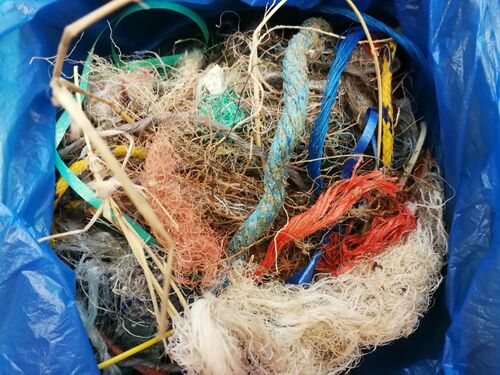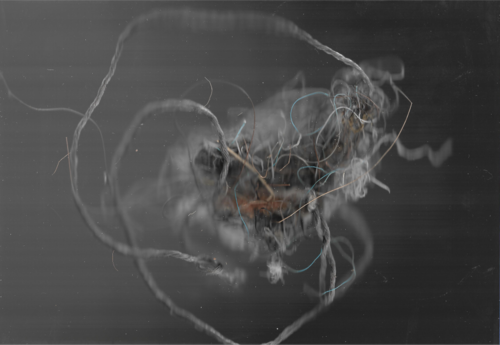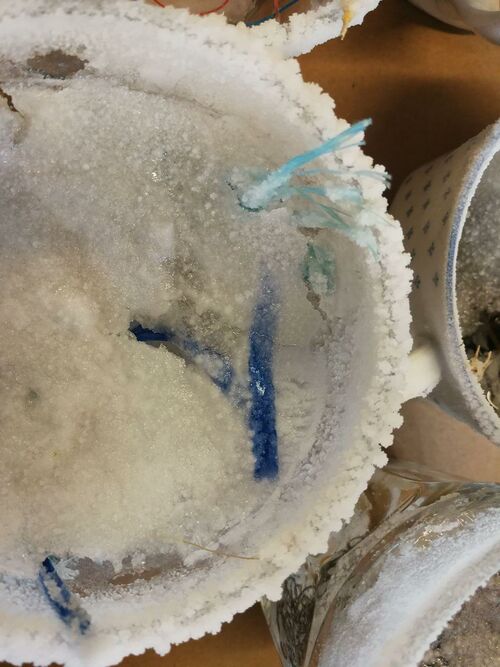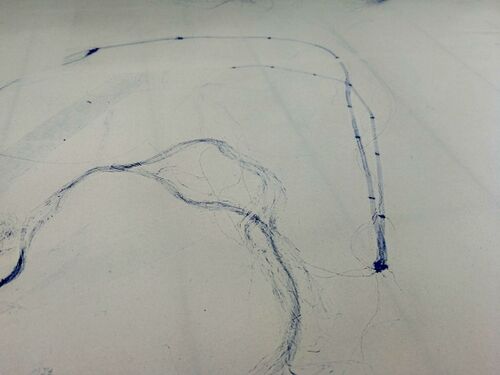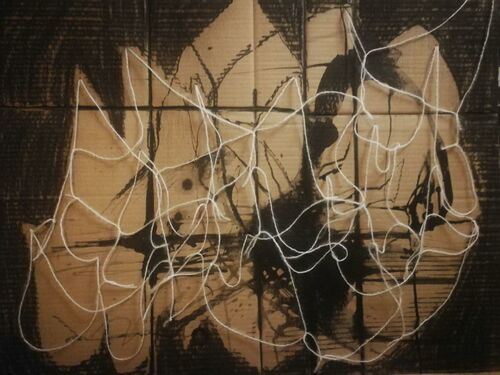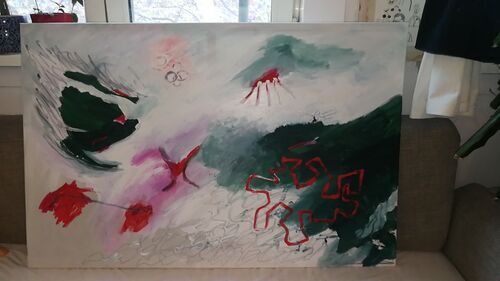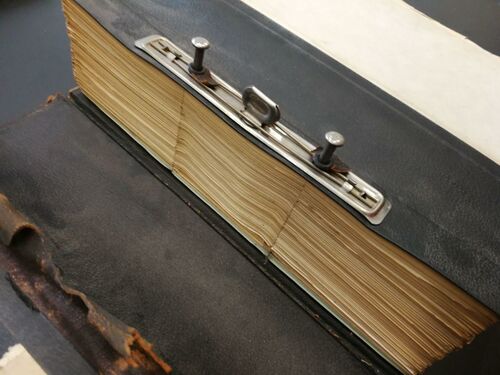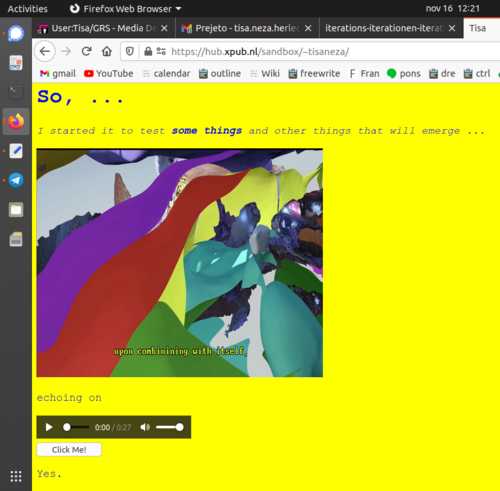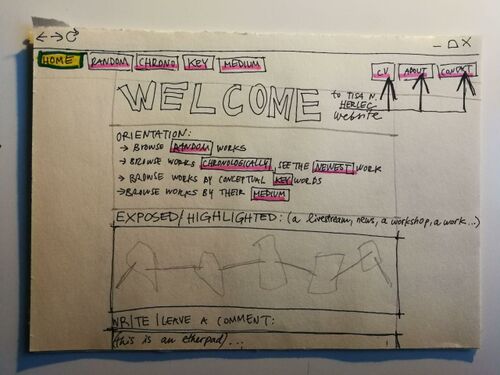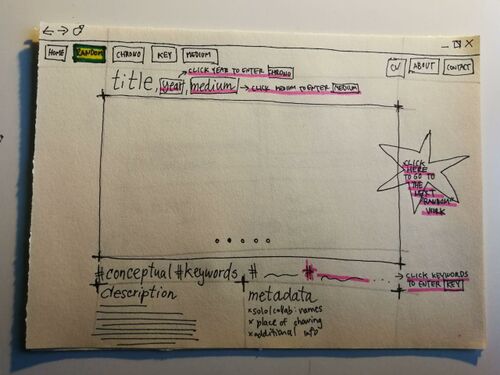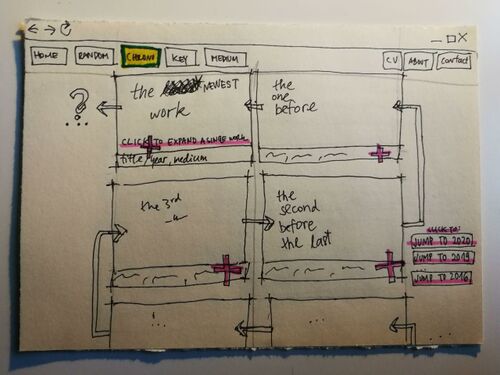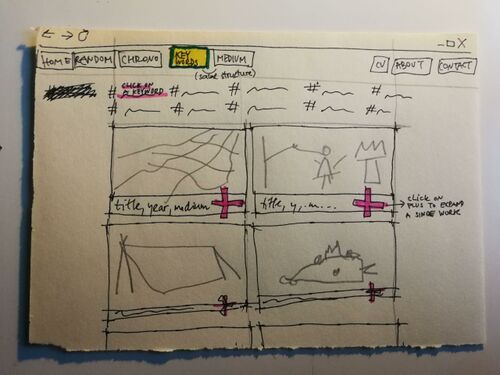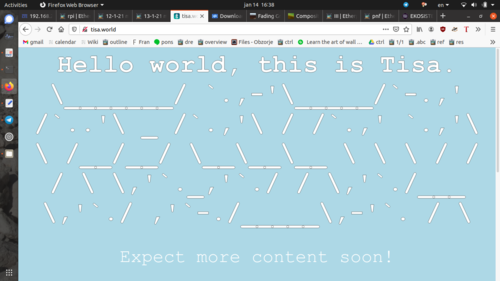User:Tisa/GRS: Difference between revisions
| (64 intermediate revisions by one other user not shown) | |||
| Line 1: | Line 1: | ||
= | =PROJECT PROPOSAL= | ||
Tisa N. Herlec | |||
I work with the mediums of: text, sound (extended vocal techniques), performance, objects/sculpture, visual (painting, drawing, printmaking), publication/zine, workshops. I am the kind of a creator that makes connections, extends, overflows, chaoticizes, my methodology is the one of addition (it is X AND also X). | |||
... | Collaboration is my main principle in creation – whether between humans (me, collaborators, the public, institutions), works, materials, concepts, ... tinkering, collecting, making, assembling as well as analysing, observing, writing, conversing, playing, ... are in motion. The presence of the other stirs the work and the possibility of perceiving reality into unknown, sometime unimaginable directions. The system is open and anything could happen. Discursive encounters shape everyone involved. Exchange happens. Cybernetic feedback loops are constant. | ||
And improvisation as a strategy is crucial. I believe that engaging in practices of improvisation enhance sensibility and awareness, build our capacities for interaction, communication and community building. They aid us unravel hidden patterns of behavior, open potentialities and options, and construct our own methodologies of being and creating in the world. I will continue to improvise and to share this practice and its affordances with others. (See more below in: [https://pzwiki.wdka.nl/mediadesign/User:Tisa/GRS#P.S.:_important P.S.:Important]). | |||
==The Constitution== | |||
"The Constitution" will be a multiplicity of works assembled in a dynamic installation, parallel to a self-hosted website. | |||
The installation and the site present a holistic assemblage of my work, and are the infrastructure that will allow me to open my imaginary to others and trigger a cybernetic circular causal relationship (already established in collaborative segments of my practice). Hence, neither the installation nor the website will be static. Using the protocols of exchange described below, I will generate, dynamicize, share and set concepts in motion together with others. | |||
"The Constitution" will have a dual function. | |||
First: | |||
It will provide an archival snapshot of a particular moment in my research practice, a trail of breadcrumbs left by my process, a nest for thoughts and their physical manifestation. The works that I will make up to that point and their documentation will inhabit the physical space that will frame and tame them. The website will be the manifestation of the space in a digital realm. | |||
Second: | |||
The space will function as the mediator, the plateau of exchange between my imaginary and others' imaginaries. I will open up the space, letting others peek inside my head and experience the multiplicity, the entanglement of works and concepts they emerged from. The space will be open to the public in a time-frame from 10.00 to 20.00 from X. 7. 2020 to X. 7. 2020. In this time I will be present in the space. I will engage in protocols of exchange with them, letting them effect my creative process; changing and rearranging the constituted space and also generating new works in it together with others. | |||
More concretely: I will set up a discursive corner in the space. There, I will engage in conversations with others and drink coffee. I will give tours of the space and tell stories and visions behind the works that constitute it. I will perform in the space (using it as a stage) and propose workshops to others. While doing all of this, I will collect imaginaries/responses/associations in different formats such as audio recording, writing (visitors' book and a notepad on my website). If the covid restrictions will be still in place, I will make livestreams of performances and host virtual discussions and workshops on my website, as well as set up a live webcam transmission from "The Constitution" for the duration of its opening hours. | |||
All of the data that I will have gathered will effect the space and the works in it, interventions done by me or others will continuously change it, generating something unforeseeable. The project will be an experience in itself, a long-durational performative action and an encounter between variables and constants. | |||
It is absolutely necessary for me to establish "The Constitution" as a physical space (regardless the restrictions of contact with the public), in itself it is performative, a process in-constitution. With this, I will allow potentialities to emerge, document the already existing and noticed ones, archiving versions of my works, establish a discourse that is provisional and in its approaches propositional. My process and my works will get a chance at a recurrent dynamicization, unfolding with the presence, the action, the interventions and the insights of others. "The Constitution" is an infrastructure that contains and facilitates flow and improvisation, it defines and enables actions and interactions, a recursive change, a space to learn from each other through conversations and its materializations. | |||
"The Constitution" will also function as a stage, allowing a series of performative (inter)actions and collaborations to take place. | |||
There will be performances of: | |||
* A duo "ch" with Linus Bonduelle using self-made instruments (found objects amplified by contact microphones, analog effects and voices, developing an improvisational discourse between imaginary characters. [https://pzwiki.wdka.nl/mediadesign/User:Tisa/practice#ch See more here.] | |||
* An augmentable duo "cTrL+" with a cellist Lucija Gregov, inviting another musician into the performance, augmenting our collaboration, expanding its "function". (cTrL+P for example) [https://pzwiki.wdka.nl/mediadesign/User:Tisa/practice#cTrL See more here.] | |||
* My solo performance. [https://soundcloud.com/tisaneza Hear snippets of my soundmaking here.] | |||
The already existing pursuits in the medium of sound outlined above will expand into: radioplays, field recordings, poetry, sound installations in public space, soundwalks, new collaborations and improvised performances. | |||
==Topos== | |||
The meta infrastructure of the space reflects my research interest and is closely related to my thesis outline. | |||
A semiotic vision guides my research, metaphorically representing it and giving it a materiality: | |||
''A school of fish is swarming in the water. Their movement is rapid, dynamic, consistent, governed by a natural order, flow. Suddenly and silently a fishnet bursts into the water, engulfs a portion of the fish and the human drags them onto the surface. They will die, be gutted and cleaned, sold, bought, consumed, perhaps discarted. The net makes the fish become a part of a system of processing and consumption (that is not their natural ecosystem), imposes a structure onto their being. The remaining fish recurrently reorganize themselves, schooling forward as if nothing had happened.'' | |||
I am fascinated by the dynamics that such a happening produces, and the metaphorical, semiotic significance of the action of fishing (represented by the fishnet and its materiality): an act of framing happens, a possibly repressive rupture of one system, a passage onto another. Paranodalities emerge. I question on what is inside (a system, a network, the net, the habit, the imaginary), what is outside, what are the characteristics of the permeable membrane in-between, what are the dynamics from/towards the inside/outside, intra-actions that happen, frictions that are constant. All of this also happens between humans: between me and the people that I collaborate with (engage in a common creative process), and also others (the public) that encounters me and my works - through a discursive interactional logic (exchange), including workshops (of sensibilization and improvisation) in which I will directly share some of my insights and methods (collected in chapter [III], the manual). | |||
I think of: mycelium, roots, lineages, spiders' webs, weaving, entangled matter, chem-trails, transportation pathways, movement, ... | |||
I think of: chaos, flow, homeostasis, structure, networks, organization, taxonomy, process, disciplines, hegemony, ... | |||
I reside somewhere in the middle, grasping for air and observing. | |||
==Material works== | |||
My material works have sprouted from the fascination with nets and ropes: their formal constitution. The way they encompass, leave out, capture, arrange, dissect - and are, in themselves, dissected, decomposed, washed ashore, polluting, ... | |||
(More concretely I will talk about these objects in chapter [II], a fiction story told by the discarded fishnet.) | |||
An outline of emerging works that are going to find their place in "The Constitution" and that are driving my material process ahead: | |||
*Material found on the beach - nets: | |||
[[File:Photo_2020-10-07_14-52-34.jpg|500px]] | |||
. | *Scanned: | ||
[[File:Scanned_threads.png|500px]] | |||
* | *Experiments with salt that unify the detached materials: | ||
[[File:Photo_2020-10-14_10-42-22.jpg|500px]] | |||
*[ | *Printmaking with the found material: | ||
[[File:Indigo.jpg|500px]] | |||
*Working with threads, "A dark thought with a good purpose": | |||
[[File:Dark.jpg|500px]] | |||
*Painting the in-between spaces, "A battle of energies in the sky" | |||
[[File:Slika_nova_2020.jpg|500px]] | |||
*Archiving my visual research in [https://pzwiki.wdka.nl/mediadesign/User:Tisa/practice#archival_book_of_visual_research this book]: | |||
[[File:Photo 2020-10-07 14-39-00.jpg|500px]] | |||
The ongoing work will expand into ceramic sculptures eaten by salt, crystal and mycelium growing pursuits, sculptural knotting of strings and threads and nets (also in a form of a spatial installation), ... I will let material and thought to intuitively guide me. Process is crucial for me. | |||
==Website== | |||
In the digital part of my project - my website - I will deploy these features: | |||
* | *self-hosting on a Raspberry Pi | ||
* | *an instance of mediawiki (data/archive organization) | ||
* | *metadata fields (extra info on works - semantic and episodic) | ||
*an open notebook/comment | |||
*playlists (changing speed) | |||
*text to speech instant subtitles generator | |||
*visualisation of sound | |||
*livestreaming | |||
*freewriting tool (python nltk library) | |||
*... | |||
This is my first tryout on the sandbox, using the Jupyter notebooks: | |||
[[File:Website sandbox.png|500px]] | |||
This sketch serves me as the starting point. Within my website, I want to produce narratives made out of different media (picture, video, sound, text), intuitive flows of associations across the entanglements of my works that the website will archive (and afford new ones to emerge). I will make a linking structure between the elements, a system of indexing (Mediawiki queries). | |||
The MediaWiki categories are outlined as followed: | |||
*conceptual keywords (being determined while archiving the work. They will trace the conceptual "red threads".) | |||
*title of the work | |||
*time of creation of the work | |||
*solo/collaborative work | |||
*material medium (painting, performance, sound, object, installation, writing, organization) | |||
*place of showing (radio, gallery, space, public space, publication, nowhere) | |||
*other (affordances of wiki's "red missing link"). | |||
The public will be able to navigate through my works in an intuitive, hypertext fashion. My website will be simultaneously an archive and an instant-publishing platform. An infrastructure that will allow me to make visible, to share, experiment and disseminate knowledge, and to be in contact with the public. | |||
===Updates=== | |||
Here are some preliminary sketches (2-12-20): | |||
[[File:Photo 2020-12-02 16-17-19.jpg|500px]] | |||
[[File:Photo 2020-12-02 16-17-23.jpg|500px]] | |||
[[File:Photo 2020-12-02 16-17-57.jpg|500px]] | |||
[[File:Photo 2020-12-02 16-17-59.jpg|500px]] | |||
[ | On 13-1-21 I have a running RaspberryPi linked with the domain [http://tisa.world tisa.world]: | ||
[[File:Screenshot tdw.png|500px]] | |||
*" | ==Tools== | ||
In the realm of technology, I will also attempt to construct the following tools for documentation of my elusive practice: | |||
*[https://pzwiki.wdka.nl/mediadesign/User:Tisa/practice#Post-production_of_experience "A sculpture made out of focus"], a gyroscope following the movements I make while performing, compiling them into a 3D drawing, printing a 3D sculpture. | |||
*An earphone microphone which I will use to make field recordings and recordings of conversations on walks. | |||
*A pedal camera with which I will capture single moments in my studio space and instantly publish them to a segment on my website. | |||
*a bash imagemagick script that will order and edit the images that go into my Archival book of visual research. | |||
*More contact microphone instruments (already used in the duo "ch"). | |||
==Methodologies/Research strategies== | |||
* | *reading and constructing a real-time research log (reading annotations+intertextual links, also summaries of texts and own thoughts on texts, reading theory as if it was poetry (observing own emotion, thoughts, connections); | ||
*writing responses to texts, short essays; | |||
*co-writing/thinking with others - chapter [I]; | |||
*recording and transcribing my presentations and tutorials, keeping a diary of my insights/shifting perspectives; | |||
*recording myself speaking and writing intuitively (I call it freewriting); | |||
*writing fiction (poetry, stories) - chapter [II]; | |||
*observing/visions/images/hallucinations; | |||
*transcribing content (words) from sound improvisation; | |||
*making an overview of my works (archival and generative); | |||
*analysis of my works and the process that made them; | |||
*making notes of conversations w/friends; | |||
*interviewing practitioners - chapter [III]; | |||
*being interviewed by others; | |||
*exchanging letters; | |||
*visual/sculptural: thinking with material, depicting of concepts; | |||
*collecting objects; | |||
*giving form to process-generated data (booklets, sound pieces); | |||
*sound improvisation alone & w/others; | |||
*writing scripts/compositions/exercises (the manual) - chapter [III]; | |||
*shifting scale principle (concepts will be applied to different scales, making parallels: x > macro > micro > x ... x > personal > societal > political > x) | |||
* ... | |||
* | I want to learn from: | ||
*myself and my self-generated data, practice, experience. | |||
My intuitive, rhizomatic chaosmos/my practice is [https://pzwiki.wdka.nl/mediadesign/User:Tisa/practice documented here.] | |||
* | *the insights and the works of the people that I personally know. | ||
*the theoretical works in the field. | |||
[https://pzwiki.wdka.nl/mediadesign/User:Tisa/research_log See my research log here.] | |||
The key terms describing my methodologies are: | |||
* | *second-order cybernetics; | ||
* | *discursive; | ||
* | *divergent thinking; | ||
* | *inductive reasoning; | ||
*practice-based research; | |||
*polyvocal, polymorphous and polyamorous. | |||
= | ==Timetable== | ||
All the time: | |||
*making material works | |||
*documentation | |||
*making notes | |||
*performing (as much as restrictions allow or streaming) | |||
November: | |||
*sketch website infrastructure | |||
*learn nltk, css, html | |||
*writing fictional story, chapter [II] | |||
*find a space that will become "The Constitution" | |||
*finish the bash imagemagick script | |||
*19-11-20: py.rate.chnic workshop: a)PART_to_de(PART with Ioana Tomici and Mark van de Heuvel | |||
December: | |||
*4-12: Deadline First Chapter | |||
*17-12: RADADAR digestive circuit event (Cirkulacija2, Ljubljana, SI) | |||
*set up the Raspberry Pi self-hosting, install WikiMedia | |||
*learn nltk, css, html | |||
*make text to speech work | |||
*arrange my archive, documentation of my previous works (for the website) | |||
*cowriting, chapter [I] | |||
January: | |||
* | *make interviews, chapter [III] | ||
*analyse, test, arrange data, chapter [III] | |||
*make the manual, chapter [III] | |||
*building my website | |||
( | February: | ||
*Deadline First Draft Thesis | |||
*building my website | |||
*making the gyroscope tool ("The sculpture made out of focus") | |||
*making the pedal camera instant publishing tool | |||
* | March: | ||
*Deadline Second Draft thesis (texts to 2nd readers) | |||
*building my website | |||
* | April: | ||
*Thesis Deadline | |||
*adding thesis texts to my website | |||
*Finalizing the infrastructure of my website | |||
( | May: | ||
*adding documentation of my works to the website | |||
*residency+performance with cTrL+KG (Kino Šiška, Ljubljana, SI) | |||
* | June: | ||
*Inhabiting "The Constitution" | |||
* | July: | ||
*opening "The Constitution" to the public | |||
... | |||
=THESIS OUTLINE= | |||
Tisa N. Herlec | |||
( | The written part of my thesis will be constructed out of three chapters. | ||
In each, I will discuss one aspect of my research interest using different forms ([I]: a collectively written essay, [II]: a fiction story, [III]: a manual). | |||
These texts, following different writing forms, will be conceptually connected to each other. In every chapter I will include an account on my practice, a subchapter charting the key insights that the works that I make provide. | |||
My graduation project "The Constitution" makes a performative record of my practice, it encompasses my process and archives it, and with its encounter with others it progresses and changes, generating subsequent works, influencing and framing the existent ones. This process is conducted within the notion of a cybernetic feedback loop dynamic. | |||
The thesis follows a similar protocol. There is a framework to my thesis - three chapters written (2000-3000 words each) within defined form(at)s. A cybernetic collaboration occurs in all three. | |||
==Chapters== | |||
===[I]=== | |||
Form: a cowritten essay | |||
Object: field report | |||
In the first chapter of my thesis, a cowritten essay will be produced, an exchange between two thinkers - myself and my friend Leon Holsten. Discourse will unravel in our dialogues (phone conversations and collaborative writing). We will share our own personal experiences of the texts and other references that we are studying together. Writing this text will be an experiment in collaborative writing and a negotiation between standpoints, a study of tensions that might emerge when two conceptual apparatuses find themselves in an in-depth encounter. Publishing this text will allow for a response from its readers (in a form of open commentary section on my website), a possible versioning of successive texts, and expansion into other discursive collaborations with my cowriter. | |||
The text will speak about the entanglements that humans take part in. It will take sound as the phenomenon guiding our research of multiplicities and intra-actions between elements in an (eco)system. The domain of field recordings will serve as an inspiration, and so will specific cases of the natural systems adapting to the human interventions into them. Paranodality and non-spaces will be mentioned as the areas of the outside, the tracing of marginalia that pushes the dynamics of influence from the entryways and passages into the networked weave of inseparable elements. | |||
Keywords: | |||
entanglement, exchange, influence, networks, collaboration, birds, sensibility, noticing the intricate, implicit multiplicities, paranodal spaces, conglomerates, additive, field recordings, acoustic ecology, cyborgs, ... | |||
===[II]=== | |||
Form: a fiction story | |||
Object: nets | |||
In the second chapter, the fiction story, I will think and write together with the material that is guiding my works - a discarted, deconstructed fishnet, washed ashore of an anonymous beach. I will embody - personify it and let it tell its story through language. This chapter is closely connected to the material works that I will be making this year. (See my "semiotic vision" in the project proposal - it is the ground on which I will build this story on.) | |||
The narrative will expand from the material itself, speaking about the relation of flow and systems, movement and stillness, birth and pollution, cycles of passing from one structure to another. The net will speak of society's mechanisms of shaping bodies and materials, hegemonic control and governance, the conception of a tool, the externalization of human intent and industrial revolution: the influence of machines/technology on contemporary conceptions of humans and materials (also: dopamine, disembodiment, attention economy, distraction). The principle of personification of a material will allow me to speak on behalf of the material and also on behalf of humans. The net will stumble across social contracts, habitus, normalization. | |||
Keywords: | |||
systems, networks, structures, material, matter, composition, hegemony, social contracts, disobedience, violence, bodies, form, tradition, influence, ... | |||
===[III]=== | |||
Form: a manual | |||
Object: the interviews | |||
In the third chapter, the manual, I will find inspiration and guidelines to improvisation in collaboration with various practitioners. In the context of a weekly radioshow at Worm Radio (hosted by me, starting in January 2021), I will interview them about: their processes, approaches to the construction of their works, specific practices they do to enter the state of flow, their relation to the documentation of performative, elusive works; and about the ways their past works relate to newer ones. When applicable to the individuals that I will be interviewing, I will also ask them about their methods of teaching improvisation. The interviews will be semi-structured in form, allowing me to improvise on the spot and respond in real-time to the emerging topos. | |||
The data from the interviews and from my own practice will acquire a form of an assemblage, a methodological manual for improvisation and flow. In the process of writing this chapter, my role will be the one of the collector and the archiver, the one that arranges a multitude of recipes in a cookbook (methodologies in a manual) - doing so only when I will have tested, modified and taxonomized them. The manual will consist of methodologies, tactics, scripts, protocols, exercises, scores, compositional techniques and instructions that the readers will be invited to execute alone or with others, using the manual in everyday life and in generative improvisational practices in the media of their choice. My experience and the manual will further support me as a facilitator of workshops for improvisation that I will resume conducting as soon as possible (Covid), sharing methodologies in practice. In the meantime, I am building exercises that can be done in a digital environment (online video group workshops). | |||
Writing this chapter will allow me to engage in discussions with improvisers that I respect and cherish; to exchange methodologies and approaches (the back-end/backstage of their practices that are seldomly articulated). It will afford me to look at my practice of improvisation through the prism of methodologies, to analyse, expand and update. This chapter will allow the readers into the backstage of the domain of improvisation (and my own practice that is a part of it), deepening their understanding of its constitution. The recordings of the interviews and their transcripts will be publicly accessible as an addition to this chapter in the form of the radio show (AM and online). | |||
Keywords: | |||
improvisation, ubuntu, kinship, collectivity, daoism, theory of flow, chaos theory, flow, process, archive, documentation, improvisation as inherent to beings/systems, improvisation as a resistance tactic, proposition, methodologies, dynamics between improvisation and social contract, strategies of interrupting the scripting, habitus, normalization, disobedience, opposition, empowerment, unscripted dramaturgies, humor, dance, movement, playfulness/playing, collaboration, togetherness, ... | |||
... | |||
==P.S.: important== | |||
My research interest comes from an inner sway, a realization pertaining to my own constitution. I am inclined to rationally understand, categorize and systematize - the world, my own work, the processes I'm dealing with, thinking, others. This is my nemesis. I approach it by engaging into processes and activities in which I challenge my inner limitations and biases, where I search for their edges and push through them, expanding my own affordances. | |||
While improvising, I dynamicize these notions, ground myself in ever-changing processes and prospect the state of continuous flow. I unlearn, let go, get lost, find inspiration, make, think, expand. | |||
This tension persists in my practice/research where I am materially, processually, conceptually and experientially exploring the dynamics and implications of structure+composition+form+system(s)+hegemony and process+improvisation+flow+subconscious+collective+chaos+empowerment. | |||
They coexist, entangle, mingle with each other, interact. | |||
I am the embodiment of the friction that I am researching. I am currently in the process of unlearning the notion of binaries and dynamicizing my systems of thought. I share my insights with others. | |||
I am intrigued by the constitution of the world, the structures that we are a part of (as bodies effected by the mediated environment of sociality), I wish to grasp this and juxtapose it to the world as I experience it with the practice of disobedience to its chains: improvisation. I consider improvisation a domain where habitual behavior and social contracts are questioned and challenged, it is an uncharted territory filled with possibilities. | |||
Within "The Constitution" (see project proposal), I am hacking my own mind and my habitus. I believe that the constitution of my own methodologies will (when done with devotion and over time) afford me to overcome the implicit indoctrination into the systems that produced me. In my practice I wish to be propositional, to provide options to existence - not only to myself, but also to my kins, collaborators and the public. The insights that I might obtain, I will share, no matter the medium of exchange (this thesis, the works that I will make, conversations and workshops with others, ...). | |||
In the thesis, I wish to explore and expand, articulate and write down my insights, make them publicly available. This will serve as a basis for my future (collaborative) trajectory of my improvisational practice in different media. | |||
==Bibliography== | |||
== | ===[I]=== | ||
*Donna J. Haraway: A Cyborg Manifesto | |||
*Gilles Deleuze, Felix Guattari: 1000 Plateaus [multiplicity, BwO] | |||
*Karen Barad: Agential Realism: On the Importance of Material-Discursive Practices [intra-action] | |||
*Ulises Ali Mejias: Off the Network: Disrupting the Digital World [paranodality] | |||
*Marc Auge: Non-Places | |||
*Roland Barthes: From Work to Text | |||
* ... | |||
[ | ===[II]=== | ||
*Ursula Franklin: lectures [prescriptive technology] | |||
*Marcel Mauss: The Techniques of the Body | |||
*Judith Butler: Gender Trouble | |||
*Reza Negarestani: Cyclonopedia: Complicity with Anonymous Materials | |||
*Italo Calvino: Cosmicomics | |||
* ... | |||
===[III]=== | |||
*Italo Calvino: Cybernetics and Ghosts | |||
*Konstantin Stanislavski: A Students' Diary | |||
*Pauline Oliveros: Deep Listening | |||
*Antonin Artaud: The Theatre and its Double [the theatre of cruelty] | |||
*Guy Debord: The Society of the Spectacle | |||
*Amelia Jones: Body art/Performing the subject | |||
*Boris Groys: The Loneliness of the Project | |||
*Simon Yulli: All Problems of Notation Will Be Solved By the Masses | |||
* ... | |||
==Complete list of works== | |||
OBJECTS | |||
*[https://pzwiki.wdka.nl/mediadesign/User:Tisa/practice#archival_book_of_visual_research The archival book of visual research] | |||
*[https://pzwiki.wdka.nl/mediadesign/User:Tisa/practice#nets rhizomatic ready-mades + modified (salt, epoxy)] | |||
*ceramic sculptures [https://pzwiki.wdka.nl/mediadesign/User:Tisa/practice#salt eaten by salt] | |||
*growing crystals | |||
*knots and nets and weaving and bondage | |||
*... | |||
*[https://pzwiki.wdka.nl/mediadesign/User:Tisa/practice#elasticite Elasticite collection and zine] | |||
INSTALLATIONS | |||
*[https://pzwiki.wdka.nl/mediadesign/User:Tisa/practice#net_installation net installation] | |||
*... | |||
*Room for reflection | |||
*Afterlife | |||
*Balance | |||
VISUAL [https://pzwiki.wdka.nl/mediadesign/User:Tisa/practice#painting see images here] | |||
*A dark thought with a good purpose | |||
*A battle of energies in the sky | |||
*Cardboard+strings | |||
*Embossing threads | |||
*Indigo | |||
*Keys etching | |||
*Colour prints (structure) washed by rain | |||
*... | |||
*Chains | |||
*5 faces | |||
*Unshut book | |||
*Breakings | |||
PERFORMANCES | |||
*[https://pzwiki.wdka.nl/mediadesign/User:Tisa/practice#Oratory_Services Oratory Services] | |||
*[https://pzwiki.wdka.nl/mediadesign/User:Tisa/practice#Wooden_Sticks_On_A_Tractor_Fitted_With_A_Dozer_Blade Wooden Sticks On A Tractor Fitted With A Dozer Blade] | |||
*"cTrL" (cTrL+M, cTrL+V, cTrL+P, ...) w/Lucija Gregov and others | |||
*"ch" w/Linus Bonduelle | |||
*duo w/Pascal Jarchow | |||
*ProPolis | |||
*[https://soundcloud.com/jebiveter/sets/brezimen/s-asH9ORUoWjJ?fbclid=IwAR1L8qWwgyRY53j5ISiPcl3jsL2pWx9HFaukiP_1qd2ICTVEk5RnFZoprHc Brezimni Prekomorci - Nameless Overseas] | |||
*... | |||
*[https://radiostudent.si/glasba/odprti-termin-za-glasbo/no%C4%8Dni-program-ferdo night programme Ferdo] | |||
*cable performance | |||
*On the same page | |||
*Obrazi | |||
*I will become monolog | |||
*Line | |||
*Made out of stone | |||
SOUND PIECES | |||
*[https://pzwiki.wdka.nl/mediadesign/User:Tisa/practice#The_prism:_to_swarm.2C_to_fish.2C_to_school The prism: to swarm, to fish, to school] | |||
*[https://varia.zone/en/corporeal-whispers.html Re#sister: Corporeal Whispers] | |||
*[https://soundcloud.com/tisaneza/maastunnel-south-middle-north Maastunnel field recording] > in the tunnel | |||
*[https://radiostudent.si/kultura/r-a-d-a-r/1-prelet-tnh Radar: Prelet tnh] | |||
*soundwalk neibourhood stories | |||
*Worm radioplay (meeting of meeting spaces) | |||
*... | |||
*[http://www.centralala.si/nezacetniski-zacetki/?fbclid=IwAR2ITMkWQG2eg5CSK7CcM4aRP40-7cpl_eJsfuqI7Eq2i50DSSky58dmrQY Re_humanizacija V] | |||
... | EVENTS/CURATORIAL | ||
*[https://pzwiki.wdka.nl/mediadesign/User:Tisa/practice#RADADAR:_multimedia_digestive_circuit RADADAR: multimedia digestive circuit] | |||
*[https://pzwiki.wdka.nl/mediadesign/User:Tisa/practice#Who_cares.3F Who cares?] | |||
*[https://pzwiki.wdka.nl/mediadesign/User:Tisa/practice#sense_smit.28h.29ing_session Sense Smithing Session] | |||
*... | |||
*[http://atrog.org/galerija/foto/modri-kot Modri kot] happenings (expand) | |||
*RADADAR digestive circuit | |||
*[https://www.instagram.com/temp.tc/ temp.tc] | |||
*[https://www.facebook.com/events/1057527037733459/ ORL+] | |||
WORKSHOP | |||
*[https://pzwiki.wdka.nl/mediadesign/User:Tisa/practice#Composing_sensibility_session_.28CSS.29 Composing Sensibility Session] | |||
* | |||
WRITING | |||
*[https://www.deplayer.nl/events/delayer-3 De_layer #3: A possible world] | |||
*HocusBogus: Floating violet | |||
*Ona/Sie/Her | |||
*[https://pzwiki.wdka.nl/mediadesign/User:Tisa/practice#Oratory_Services Oratory Services: Infinite list, Description] | |||
*Interviews | |||
*... | |||
*Metaphors.txt | |||
*What is this? | |||
TOOLS | |||
*A sculpture made out of focus (gyro > 3D) | |||
*An earphone microphone | |||
*A pedal camera | |||
*... | |||
*Distraction manager | |||
*Dissonar | |||
*Approaching | |||
Latest revision as of 10:38, 18 May 2022
PROJECT PROPOSAL
Tisa N. Herlec
I work with the mediums of: text, sound (extended vocal techniques), performance, objects/sculpture, visual (painting, drawing, printmaking), publication/zine, workshops. I am the kind of a creator that makes connections, extends, overflows, chaoticizes, my methodology is the one of addition (it is X AND also X).
Collaboration is my main principle in creation – whether between humans (me, collaborators, the public, institutions), works, materials, concepts, ... tinkering, collecting, making, assembling as well as analysing, observing, writing, conversing, playing, ... are in motion. The presence of the other stirs the work and the possibility of perceiving reality into unknown, sometime unimaginable directions. The system is open and anything could happen. Discursive encounters shape everyone involved. Exchange happens. Cybernetic feedback loops are constant.
And improvisation as a strategy is crucial. I believe that engaging in practices of improvisation enhance sensibility and awareness, build our capacities for interaction, communication and community building. They aid us unravel hidden patterns of behavior, open potentialities and options, and construct our own methodologies of being and creating in the world. I will continue to improvise and to share this practice and its affordances with others. (See more below in: P.S.:Important).
The Constitution
"The Constitution" will be a multiplicity of works assembled in a dynamic installation, parallel to a self-hosted website.
The installation and the site present a holistic assemblage of my work, and are the infrastructure that will allow me to open my imaginary to others and trigger a cybernetic circular causal relationship (already established in collaborative segments of my practice). Hence, neither the installation nor the website will be static. Using the protocols of exchange described below, I will generate, dynamicize, share and set concepts in motion together with others.
"The Constitution" will have a dual function.
First: It will provide an archival snapshot of a particular moment in my research practice, a trail of breadcrumbs left by my process, a nest for thoughts and their physical manifestation. The works that I will make up to that point and their documentation will inhabit the physical space that will frame and tame them. The website will be the manifestation of the space in a digital realm.
Second: The space will function as the mediator, the plateau of exchange between my imaginary and others' imaginaries. I will open up the space, letting others peek inside my head and experience the multiplicity, the entanglement of works and concepts they emerged from. The space will be open to the public in a time-frame from 10.00 to 20.00 from X. 7. 2020 to X. 7. 2020. In this time I will be present in the space. I will engage in protocols of exchange with them, letting them effect my creative process; changing and rearranging the constituted space and also generating new works in it together with others.
More concretely: I will set up a discursive corner in the space. There, I will engage in conversations with others and drink coffee. I will give tours of the space and tell stories and visions behind the works that constitute it. I will perform in the space (using it as a stage) and propose workshops to others. While doing all of this, I will collect imaginaries/responses/associations in different formats such as audio recording, writing (visitors' book and a notepad on my website). If the covid restrictions will be still in place, I will make livestreams of performances and host virtual discussions and workshops on my website, as well as set up a live webcam transmission from "The Constitution" for the duration of its opening hours.
All of the data that I will have gathered will effect the space and the works in it, interventions done by me or others will continuously change it, generating something unforeseeable. The project will be an experience in itself, a long-durational performative action and an encounter between variables and constants.
It is absolutely necessary for me to establish "The Constitution" as a physical space (regardless the restrictions of contact with the public), in itself it is performative, a process in-constitution. With this, I will allow potentialities to emerge, document the already existing and noticed ones, archiving versions of my works, establish a discourse that is provisional and in its approaches propositional. My process and my works will get a chance at a recurrent dynamicization, unfolding with the presence, the action, the interventions and the insights of others. "The Constitution" is an infrastructure that contains and facilitates flow and improvisation, it defines and enables actions and interactions, a recursive change, a space to learn from each other through conversations and its materializations.
"The Constitution" will also function as a stage, allowing a series of performative (inter)actions and collaborations to take place.
There will be performances of:
- A duo "ch" with Linus Bonduelle using self-made instruments (found objects amplified by contact microphones, analog effects and voices, developing an improvisational discourse between imaginary characters. See more here.
- An augmentable duo "cTrL+" with a cellist Lucija Gregov, inviting another musician into the performance, augmenting our collaboration, expanding its "function". (cTrL+P for example) See more here.
- My solo performance. Hear snippets of my soundmaking here.
The already existing pursuits in the medium of sound outlined above will expand into: radioplays, field recordings, poetry, sound installations in public space, soundwalks, new collaborations and improvised performances.
Topos
The meta infrastructure of the space reflects my research interest and is closely related to my thesis outline.
A semiotic vision guides my research, metaphorically representing it and giving it a materiality:
A school of fish is swarming in the water. Their movement is rapid, dynamic, consistent, governed by a natural order, flow. Suddenly and silently a fishnet bursts into the water, engulfs a portion of the fish and the human drags them onto the surface. They will die, be gutted and cleaned, sold, bought, consumed, perhaps discarted. The net makes the fish become a part of a system of processing and consumption (that is not their natural ecosystem), imposes a structure onto their being. The remaining fish recurrently reorganize themselves, schooling forward as if nothing had happened.
I am fascinated by the dynamics that such a happening produces, and the metaphorical, semiotic significance of the action of fishing (represented by the fishnet and its materiality): an act of framing happens, a possibly repressive rupture of one system, a passage onto another. Paranodalities emerge. I question on what is inside (a system, a network, the net, the habit, the imaginary), what is outside, what are the characteristics of the permeable membrane in-between, what are the dynamics from/towards the inside/outside, intra-actions that happen, frictions that are constant. All of this also happens between humans: between me and the people that I collaborate with (engage in a common creative process), and also others (the public) that encounters me and my works - through a discursive interactional logic (exchange), including workshops (of sensibilization and improvisation) in which I will directly share some of my insights and methods (collected in chapter [III], the manual).
I think of: mycelium, roots, lineages, spiders' webs, weaving, entangled matter, chem-trails, transportation pathways, movement, ... I think of: chaos, flow, homeostasis, structure, networks, organization, taxonomy, process, disciplines, hegemony, ... I reside somewhere in the middle, grasping for air and observing.
Material works
My material works have sprouted from the fascination with nets and ropes: their formal constitution. The way they encompass, leave out, capture, arrange, dissect - and are, in themselves, dissected, decomposed, washed ashore, polluting, ... (More concretely I will talk about these objects in chapter [II], a fiction story told by the discarded fishnet.)
An outline of emerging works that are going to find their place in "The Constitution" and that are driving my material process ahead:
- Material found on the beach - nets:
- Scanned:
- Experiments with salt that unify the detached materials:
- Printmaking with the found material:
- Working with threads, "A dark thought with a good purpose":
- Painting the in-between spaces, "A battle of energies in the sky"
- Archiving my visual research in this book:
The ongoing work will expand into ceramic sculptures eaten by salt, crystal and mycelium growing pursuits, sculptural knotting of strings and threads and nets (also in a form of a spatial installation), ... I will let material and thought to intuitively guide me. Process is crucial for me.
Website
In the digital part of my project - my website - I will deploy these features:
- self-hosting on a Raspberry Pi
- an instance of mediawiki (data/archive organization)
- metadata fields (extra info on works - semantic and episodic)
- an open notebook/comment
- playlists (changing speed)
- text to speech instant subtitles generator
- visualisation of sound
- livestreaming
- freewriting tool (python nltk library)
- ...
This is my first tryout on the sandbox, using the Jupyter notebooks:
This sketch serves me as the starting point. Within my website, I want to produce narratives made out of different media (picture, video, sound, text), intuitive flows of associations across the entanglements of my works that the website will archive (and afford new ones to emerge). I will make a linking structure between the elements, a system of indexing (Mediawiki queries).
The MediaWiki categories are outlined as followed:
- conceptual keywords (being determined while archiving the work. They will trace the conceptual "red threads".)
- title of the work
- time of creation of the work
- solo/collaborative work
- material medium (painting, performance, sound, object, installation, writing, organization)
- place of showing (radio, gallery, space, public space, publication, nowhere)
- other (affordances of wiki's "red missing link").
The public will be able to navigate through my works in an intuitive, hypertext fashion. My website will be simultaneously an archive and an instant-publishing platform. An infrastructure that will allow me to make visible, to share, experiment and disseminate knowledge, and to be in contact with the public.
Updates
Here are some preliminary sketches (2-12-20):
On 13-1-21 I have a running RaspberryPi linked with the domain tisa.world:
Tools
In the realm of technology, I will also attempt to construct the following tools for documentation of my elusive practice:
- "A sculpture made out of focus", a gyroscope following the movements I make while performing, compiling them into a 3D drawing, printing a 3D sculpture.
- An earphone microphone which I will use to make field recordings and recordings of conversations on walks.
- A pedal camera with which I will capture single moments in my studio space and instantly publish them to a segment on my website.
- a bash imagemagick script that will order and edit the images that go into my Archival book of visual research.
- More contact microphone instruments (already used in the duo "ch").
Methodologies/Research strategies
- reading and constructing a real-time research log (reading annotations+intertextual links, also summaries of texts and own thoughts on texts, reading theory as if it was poetry (observing own emotion, thoughts, connections);
- writing responses to texts, short essays;
- co-writing/thinking with others - chapter [I];
- recording and transcribing my presentations and tutorials, keeping a diary of my insights/shifting perspectives;
- recording myself speaking and writing intuitively (I call it freewriting);
- writing fiction (poetry, stories) - chapter [II];
- observing/visions/images/hallucinations;
- transcribing content (words) from sound improvisation;
- making an overview of my works (archival and generative);
- analysis of my works and the process that made them;
- making notes of conversations w/friends;
- interviewing practitioners - chapter [III];
- being interviewed by others;
- exchanging letters;
- visual/sculptural: thinking with material, depicting of concepts;
- collecting objects;
- giving form to process-generated data (booklets, sound pieces);
- sound improvisation alone & w/others;
- writing scripts/compositions/exercises (the manual) - chapter [III];
- shifting scale principle (concepts will be applied to different scales, making parallels: x > macro > micro > x ... x > personal > societal > political > x)
- ...
I want to learn from:
- myself and my self-generated data, practice, experience.
My intuitive, rhizomatic chaosmos/my practice is documented here.
- the insights and the works of the people that I personally know.
- the theoretical works in the field.
The key terms describing my methodologies are:
- second-order cybernetics;
- discursive;
- divergent thinking;
- inductive reasoning;
- practice-based research;
- polyvocal, polymorphous and polyamorous.
Timetable
All the time:
- making material works
- documentation
- making notes
- performing (as much as restrictions allow or streaming)
November:
- sketch website infrastructure
- learn nltk, css, html
- writing fictional story, chapter [II]
- find a space that will become "The Constitution"
- finish the bash imagemagick script
- 19-11-20: py.rate.chnic workshop: a)PART_to_de(PART with Ioana Tomici and Mark van de Heuvel
December:
- 4-12: Deadline First Chapter
- 17-12: RADADAR digestive circuit event (Cirkulacija2, Ljubljana, SI)
- set up the Raspberry Pi self-hosting, install WikiMedia
- learn nltk, css, html
- make text to speech work
- arrange my archive, documentation of my previous works (for the website)
- cowriting, chapter [I]
January:
- make interviews, chapter [III]
- analyse, test, arrange data, chapter [III]
- make the manual, chapter [III]
- building my website
February:
- Deadline First Draft Thesis
- building my website
- making the gyroscope tool ("The sculpture made out of focus")
- making the pedal camera instant publishing tool
March:
- Deadline Second Draft thesis (texts to 2nd readers)
- building my website
April:
- Thesis Deadline
- adding thesis texts to my website
- Finalizing the infrastructure of my website
May:
- adding documentation of my works to the website
- residency+performance with cTrL+KG (Kino Šiška, Ljubljana, SI)
June:
- Inhabiting "The Constitution"
July:
- opening "The Constitution" to the public
...
THESIS OUTLINE
Tisa N. Herlec
The written part of my thesis will be constructed out of three chapters. In each, I will discuss one aspect of my research interest using different forms ([I]: a collectively written essay, [II]: a fiction story, [III]: a manual).
These texts, following different writing forms, will be conceptually connected to each other. In every chapter I will include an account on my practice, a subchapter charting the key insights that the works that I make provide.
My graduation project "The Constitution" makes a performative record of my practice, it encompasses my process and archives it, and with its encounter with others it progresses and changes, generating subsequent works, influencing and framing the existent ones. This process is conducted within the notion of a cybernetic feedback loop dynamic.
The thesis follows a similar protocol. There is a framework to my thesis - three chapters written (2000-3000 words each) within defined form(at)s. A cybernetic collaboration occurs in all three.
Chapters
[I]
Form: a cowritten essay
Object: field report
In the first chapter of my thesis, a cowritten essay will be produced, an exchange between two thinkers - myself and my friend Leon Holsten. Discourse will unravel in our dialogues (phone conversations and collaborative writing). We will share our own personal experiences of the texts and other references that we are studying together. Writing this text will be an experiment in collaborative writing and a negotiation between standpoints, a study of tensions that might emerge when two conceptual apparatuses find themselves in an in-depth encounter. Publishing this text will allow for a response from its readers (in a form of open commentary section on my website), a possible versioning of successive texts, and expansion into other discursive collaborations with my cowriter.
The text will speak about the entanglements that humans take part in. It will take sound as the phenomenon guiding our research of multiplicities and intra-actions between elements in an (eco)system. The domain of field recordings will serve as an inspiration, and so will specific cases of the natural systems adapting to the human interventions into them. Paranodality and non-spaces will be mentioned as the areas of the outside, the tracing of marginalia that pushes the dynamics of influence from the entryways and passages into the networked weave of inseparable elements.
Keywords: entanglement, exchange, influence, networks, collaboration, birds, sensibility, noticing the intricate, implicit multiplicities, paranodal spaces, conglomerates, additive, field recordings, acoustic ecology, cyborgs, ...
[II]
Form: a fiction story
Object: nets
In the second chapter, the fiction story, I will think and write together with the material that is guiding my works - a discarted, deconstructed fishnet, washed ashore of an anonymous beach. I will embody - personify it and let it tell its story through language. This chapter is closely connected to the material works that I will be making this year. (See my "semiotic vision" in the project proposal - it is the ground on which I will build this story on.)
The narrative will expand from the material itself, speaking about the relation of flow and systems, movement and stillness, birth and pollution, cycles of passing from one structure to another. The net will speak of society's mechanisms of shaping bodies and materials, hegemonic control and governance, the conception of a tool, the externalization of human intent and industrial revolution: the influence of machines/technology on contemporary conceptions of humans and materials (also: dopamine, disembodiment, attention economy, distraction). The principle of personification of a material will allow me to speak on behalf of the material and also on behalf of humans. The net will stumble across social contracts, habitus, normalization.
Keywords: systems, networks, structures, material, matter, composition, hegemony, social contracts, disobedience, violence, bodies, form, tradition, influence, ...
[III]
Form: a manual
Object: the interviews
In the third chapter, the manual, I will find inspiration and guidelines to improvisation in collaboration with various practitioners. In the context of a weekly radioshow at Worm Radio (hosted by me, starting in January 2021), I will interview them about: their processes, approaches to the construction of their works, specific practices they do to enter the state of flow, their relation to the documentation of performative, elusive works; and about the ways their past works relate to newer ones. When applicable to the individuals that I will be interviewing, I will also ask them about their methods of teaching improvisation. The interviews will be semi-structured in form, allowing me to improvise on the spot and respond in real-time to the emerging topos.
The data from the interviews and from my own practice will acquire a form of an assemblage, a methodological manual for improvisation and flow. In the process of writing this chapter, my role will be the one of the collector and the archiver, the one that arranges a multitude of recipes in a cookbook (methodologies in a manual) - doing so only when I will have tested, modified and taxonomized them. The manual will consist of methodologies, tactics, scripts, protocols, exercises, scores, compositional techniques and instructions that the readers will be invited to execute alone or with others, using the manual in everyday life and in generative improvisational practices in the media of their choice. My experience and the manual will further support me as a facilitator of workshops for improvisation that I will resume conducting as soon as possible (Covid), sharing methodologies in practice. In the meantime, I am building exercises that can be done in a digital environment (online video group workshops).
Writing this chapter will allow me to engage in discussions with improvisers that I respect and cherish; to exchange methodologies and approaches (the back-end/backstage of their practices that are seldomly articulated). It will afford me to look at my practice of improvisation through the prism of methodologies, to analyse, expand and update. This chapter will allow the readers into the backstage of the domain of improvisation (and my own practice that is a part of it), deepening their understanding of its constitution. The recordings of the interviews and their transcripts will be publicly accessible as an addition to this chapter in the form of the radio show (AM and online).
Keywords: improvisation, ubuntu, kinship, collectivity, daoism, theory of flow, chaos theory, flow, process, archive, documentation, improvisation as inherent to beings/systems, improvisation as a resistance tactic, proposition, methodologies, dynamics between improvisation and social contract, strategies of interrupting the scripting, habitus, normalization, disobedience, opposition, empowerment, unscripted dramaturgies, humor, dance, movement, playfulness/playing, collaboration, togetherness, ...
...
P.S.: important
My research interest comes from an inner sway, a realization pertaining to my own constitution. I am inclined to rationally understand, categorize and systematize - the world, my own work, the processes I'm dealing with, thinking, others. This is my nemesis. I approach it by engaging into processes and activities in which I challenge my inner limitations and biases, where I search for their edges and push through them, expanding my own affordances.
While improvising, I dynamicize these notions, ground myself in ever-changing processes and prospect the state of continuous flow. I unlearn, let go, get lost, find inspiration, make, think, expand.
This tension persists in my practice/research where I am materially, processually, conceptually and experientially exploring the dynamics and implications of structure+composition+form+system(s)+hegemony and process+improvisation+flow+subconscious+collective+chaos+empowerment. They coexist, entangle, mingle with each other, interact.
I am the embodiment of the friction that I am researching. I am currently in the process of unlearning the notion of binaries and dynamicizing my systems of thought. I share my insights with others.
I am intrigued by the constitution of the world, the structures that we are a part of (as bodies effected by the mediated environment of sociality), I wish to grasp this and juxtapose it to the world as I experience it with the practice of disobedience to its chains: improvisation. I consider improvisation a domain where habitual behavior and social contracts are questioned and challenged, it is an uncharted territory filled with possibilities.
Within "The Constitution" (see project proposal), I am hacking my own mind and my habitus. I believe that the constitution of my own methodologies will (when done with devotion and over time) afford me to overcome the implicit indoctrination into the systems that produced me. In my practice I wish to be propositional, to provide options to existence - not only to myself, but also to my kins, collaborators and the public. The insights that I might obtain, I will share, no matter the medium of exchange (this thesis, the works that I will make, conversations and workshops with others, ...).
In the thesis, I wish to explore and expand, articulate and write down my insights, make them publicly available. This will serve as a basis for my future (collaborative) trajectory of my improvisational practice in different media.
Bibliography
[I]
- Donna J. Haraway: A Cyborg Manifesto
- Gilles Deleuze, Felix Guattari: 1000 Plateaus [multiplicity, BwO]
- Karen Barad: Agential Realism: On the Importance of Material-Discursive Practices [intra-action]
- Ulises Ali Mejias: Off the Network: Disrupting the Digital World [paranodality]
- Marc Auge: Non-Places
- Roland Barthes: From Work to Text
- ...
[II]
- Ursula Franklin: lectures [prescriptive technology]
- Marcel Mauss: The Techniques of the Body
- Judith Butler: Gender Trouble
- Reza Negarestani: Cyclonopedia: Complicity with Anonymous Materials
- Italo Calvino: Cosmicomics
- ...
[III]
- Italo Calvino: Cybernetics and Ghosts
- Konstantin Stanislavski: A Students' Diary
- Pauline Oliveros: Deep Listening
- Antonin Artaud: The Theatre and its Double [the theatre of cruelty]
- Guy Debord: The Society of the Spectacle
- Amelia Jones: Body art/Performing the subject
- Boris Groys: The Loneliness of the Project
- Simon Yulli: All Problems of Notation Will Be Solved By the Masses
- ...
Complete list of works
OBJECTS
- The archival book of visual research
- rhizomatic ready-mades + modified (salt, epoxy)
- ceramic sculptures eaten by salt
- growing crystals
- knots and nets and weaving and bondage
- ...
- Elasticite collection and zine
INSTALLATIONS
- net installation
- ...
- Room for reflection
- Afterlife
- Balance
VISUAL see images here
- A dark thought with a good purpose
- A battle of energies in the sky
- Cardboard+strings
- Embossing threads
- Indigo
- Keys etching
- Colour prints (structure) washed by rain
- ...
- Chains
- 5 faces
- Unshut book
- Breakings
PERFORMANCES
- Oratory Services
- Wooden Sticks On A Tractor Fitted With A Dozer Blade
- "cTrL" (cTrL+M, cTrL+V, cTrL+P, ...) w/Lucija Gregov and others
- "ch" w/Linus Bonduelle
- duo w/Pascal Jarchow
- ProPolis
- Brezimni Prekomorci - Nameless Overseas
- ...
- night programme Ferdo
- cable performance
- On the same page
- Obrazi
- I will become monolog
- Line
- Made out of stone
SOUND PIECES
- The prism: to swarm, to fish, to school
- Re#sister: Corporeal Whispers
- Maastunnel field recording > in the tunnel
- Radar: Prelet tnh
- soundwalk neibourhood stories
- Worm radioplay (meeting of meeting spaces)
- ...
- Re_humanizacija V
EVENTS/CURATORIAL
- RADADAR: multimedia digestive circuit
- Who cares?
- Sense Smithing Session
- ...
- Modri kot happenings (expand)
- RADADAR digestive circuit
- temp.tc
- ORL+
WORKSHOP
WRITING
- De_layer #3: A possible world
- HocusBogus: Floating violet
- Ona/Sie/Her
- Oratory Services: Infinite list, Description
- Interviews
- ...
- Metaphors.txt
- What is this?
TOOLS
- A sculpture made out of focus (gyro > 3D)
- An earphone microphone
- A pedal camera
- ...
- Distraction manager
- Dissonar
- Approaching

